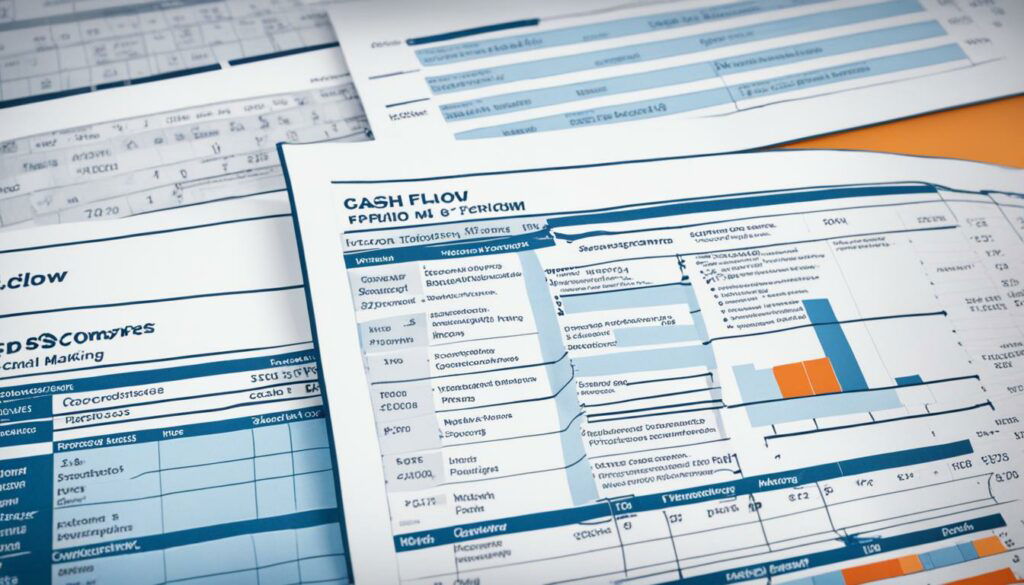Only 10% of businesses have fully automated their accounts payable (AP) processes. Yet, more companies are seeing the benefits. This includes better visibility, control, and savings by going digital. We’ll discuss how automating AP processes can enhance your cash flow management.
Key Takeaways
- Historically, generating and paying invoices is done by manual processes from end to end.
- AP automation can lead to 81% lower processing costs and 73% faster processing cycle times.
- Automating the purchasing process, from purchase orders to invoice matching and payments, can improve visibility and control.
- AP automation enables businesses to focus on more strategic tasks by reducing errors and compliance risks.
- The trend towards AP automation is growing as companies recognise the benefits for cash flow forecasting and management.
Understanding Accounts Payable (AP) Automation
In today’s world, AP teams have many challenges to overcome. They must process invoices quickly, keep accurate records, and pay on time. AP automation changes how companies handle money matters, making tasks easier and faster.
What is AP Automation?
AP automation uses special software to cut down on manual AP work. This software manages invoices from start to finish. It speeds up tasks like approving and handling invoices by using smart workflows and tech.
Key Components of AP Automation Solutions
Key AP automation features include:
- Optical Character Recognition (OCR): This tech reads invoice data for automatic digital capturing.
- E-invoicing: It lets you deal with invoices online. No need for typing in data or keeping paper copies.
- Electronic Archive: A safe digital place to keep invoices. It makes finding documents easy and helps with following rules.
- Multi-ERP Integration: It links the AP automation software with company systems. This keeps financial tasks smoothly connected.
Using these tools, companies can improve how they manage money. AP automation is often offered as software you access online. This makes managing accounts payable easier for any business.
Benefits of Implementing AP Automation
Adopting AP automation has many perks for businesses. It helps them make their financial work smoother and more efficient. These benefits include saving money and making processes run better.
Reduced Processing Costs and Cycle Times
AP automation cuts down on costs and the time it takes to process payments. Research shows companies using this tech spend 81% less on processing and do it 73% quicker than with manual methods.
Improved Visibility and Control
AP automation boosts how much a business can see and control in their payments. This happens by making invoicing, approving payments, and managing vendors automatic. With this clearer view and control, companies can manage their money and follow rules better.
Fewer Errors and Compliance Risks
Doing accounts payable by hand often leads to mistakes. These errors can be costly and cause issues with following rules. AP automation helps spot and stop problems with its error-checking and fraud spotting capabilities. This means companies can steer clear of the trouble and costs that come with errors.
By using AP automation, businesses get to focus on bigger goals. They can make their financial work better and save money. This tech is key for any company looking to stay ahead in the market.

Cash flow with ap automation
With AP automation, businesses no longer have to rely on manual processes and paperwork to manage their cash flow. This technology automates the AP processes, such as invoice processing, payment approvals, and vendor management. By replacing manual tasks with automated systems, companies can streamline their operations, reduce errors, and ensure timely payments.
One of the key benefits of AP automation is improved cash management. It provides businesses with real-time visibility into their cash flow, allowing them to track and monitor their financial transactions accurately. This visibility helps in identifying potential bottlenecks or issues that can affect cash flow and enables proactive measures to be taken. By gaining better control over cash flow, companies can optimize their working capital, minimize late payment fees, and improve relationships with suppliers and vendors.
Additionally, AP automation can help companies optimize their payment processes. It allows businesses to set up electronic payments, eliminating the need for manual cheque writing and mailing. This not only saves time but also reduces costs associated with printing and postage. With electronic payments, businesses can also take advantage of early payment discounts and negotiate better terms with vendors, further improving their cash flow.
In conclusion, cash flow management is crucial for the financial stability and growth of any business. AP automation offers a solution to effectively manage cash flow by providing real-time visibility, streamlining operations, and optimizing payment processes. By adopting AP automation, companies can improve their cash management practices, minimize errors, and maintain healthy financial relationships.
Effective cash flow management is key for a stable financial future and growth. Accounts payable (AP) automation makes managing money smoother. It give’s you more control over your company’s finances.
Automating the AP process helps you see future payments better. It makes handling invoices faster. You’ll pay your suppliers on time. This can lead to better planning for your money and smarter finance plans.
With AP automation’s help, you save money and work more efficiently. This frees up cash that can be used in different ways. You can invest more in your business, improve your working capital, or focus on important goals. This boosts your company’s cash flow and finances.
| Key Benefits of AP Automation for Cash Flow | Impact |
|---|---|
| Improved visibility into upcoming payments | Enhanced cash flow forecasting and financial planning |
| Reduced processing times and on-time payments | Stronger supplier relationships and improved cash flow |
| Cost savings and efficiency gains | Increased financial flexibility and resources for reinvestment |
Using AP automation unlocks better cash flow management. This contributes to financial stability. It opens new doors for growth and innovation.

Current Trends in AP Automation
Accounts payable (AP) automation keeps getting better with new tech like artificial intelligence (AI) and machine learning (ML). These tools help companies run their money matters more efficiently and boost productivity.
Artificial Intelligence and Machine Learning Capabilities
AI and ML are making the scanning of invoices easier with OCR. They’re so good that they need less human help to sort bills. These systems can also spot if a bill looks wrong, like a double charge or a fake invoice.
Integration with E-Invoicing Solutions
Many are moving towards e-invoicing to cut down on paper and speed up the bill process. This change is happening fast, with about £1.75 billion expected to be spent on AP automation by 2026. The market is growing about 14% every year.
Companies want to manage their money better. So, they’re mixing AP automation trends, AI, and e-invoicing to get ahead. These new tools let businesses see clearer, do better with their cash, and manage bills with more ease.
Choosing the Right AP Automation Solution
Choosing the best AP automation solution can be tricky. There are many ERP and financial systems out there, each with its own policies. Your choice should align with your business needs, like your organisation’s size and the number of invoices you handle.
Defining Your Business Requirements
To pick the right AP automation, you must first know your needs. Think about:
- The size and structure of your organisation
- The volume of invoices you process on a regular basis
- Your current accounts payable processes and pain points
- The level of visibility and control you require over your AP operations
- Your organisation’s compliance requirements, particularly in relation to e-invoicing compliance
Ensuring E-Invoicing Compliance
More places are adopting e-invoicing standards. So, your AP solution must meet these now and in the future. Looking into the vendor’s focus on AP automation is key, more than just an extra feature.
Defining your business needs and checking e-invoicing compliance are vital steps. They ensure your chosen AP automation will make things smoother and improve cash flow management.
| Feature | Importance |
|---|---|
| Compliance with e-invoicing standards | High |
| Scalability to handle invoice volume | High |
| Integration with existing ERP/financial systems | Medium |
| Customisation options | Medium |
| Vendor’s focus on AP automation | High |
Overcoming Obstacles to AP Automation Adoption
Bringing ap automation implementation to businesses has great advantages but faces challenges. Overcoming these hurdles is essential for success. It requires key steps like having an executive leader and a dedicated project manager, getting everyone on board, and managing the change well.
A major challenge is change management. The project leader needs to show why AP automation is good for everyone. They must make sure everyone knows the benefits like saving on costs, increased control, and reduced mistakes.
Getting everyone to support AP automation can be tough. Companies need to get the finance team and IT department, for example, excited and willing to help. This might mean lots of talks and showing how AP automation can work for them.
Having the right leaders is also a big deal. AP automation needs a strong project team. It’s important to have a really good project manager and support from the top.
A big solution to these challenges is a good plan for change. Showing the benefits, dealing with worries, and making sure the project has what it needs can make all the difference. This approach helps companies smoothly transition to automated accounts payable and enjoy its benefits.
Conclusion
AP automation is changing the way financial management works by making tasks more efficient. It reduces manual work and uses advanced tech. This makes data entry easier, lowers costs, and prevents lost invoices. You’ll save money and time, see where you spend more clearly, make fewer mistakes, and have more time for big plans.
Across the globe, people are asking for more e-invoicing rules to be followed. With the right AP automation, your company can manage its money better. Overcoming challenges and picking the best software will help you make the most of AP automation, making your business more flexible financially.
Using AP automation is about more than just using new technology; it’s about being smart. With the right tools, you can be more in control, avoid money problems, and do well over time. This keeps your business at the front of how finance is managed as things change.

